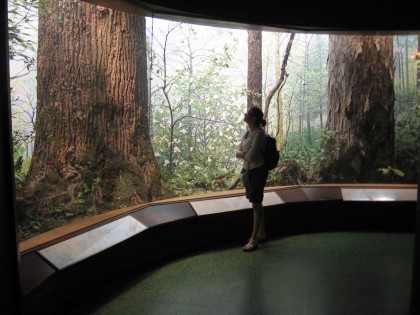
The Felix M. Warburg Hall of New York State Environment at the American Museum of Natural History explores the natural and agricultural history of Dutchess County, New York. The most striking aspect of the exhibit is its vintage design. The exhibit was opened in 1951 and has not changed since.
The vintage look is noted by visitors, as evidenced by comments on the web:
See the ultra-retro Warburg Hall of New York State Environment
The Hall of New York State Environment needs a serious makeover as it looks like a bad 70’s tv set.
I love the retro decor of wood paneling and white script lettering that surrounds the dioramas — I hope they never renovate!
The hall is a museum piece in itself, a time capsule of the state-of-the art in exhibit design at the mid-20th century. The content of the exhibit was also innovative, being the first ecologically-oriented exhibit at the museum, portraying the interrelationship of people and nature.
Although visitors understand that the look of the exhibit is retro, some may not understand that many of the conservation issues and outlooks illustrated by the exhibit are also retro.
Not a common sight these days: cows in the woods.
For example, there is a depiction of runaway cattle that have decimated the forest understory. This now minor threat to forest health has been supplanted by the much larger and less tractable problem of overabundant white-tailed deer. In fact, the lush forest understory constructed for the museum’s exhibits may now exist only in the museum and no longer be found in real-life Dutchess county as a result of deer overbrowsing. Deer as a threat to the forest understory was scarcely conceivable in 1950, when in most places efforts were still underway to restore deer populations after uncontrolled hunting during the great depression.
Only in a museum? The lush understory of the limestone forest
Chemicals feature prominently in the exhibit as tools for managing the enviroment. 1950 marked the dawn of the “green revolution” which brought chemical fertilizers, herbicides, and pesticides to prominence as a means to more efficient crop production.
Displays depict dioramas of planes spreading gauzy clouds of chemicals over forests and an apple farmer soaking trees with something sprayed from the back of a tractor.
A diorama forest gets treated for forest pests.
Mr. Farmer, please wear a tyvek suit and a respirator next time.
While chemicals still play a role today, we are also experiencing a renaissance of organic farming. Dutchess County is at the forefront of this movement, providing New York City a steady supply of local, organic produce.
The exhibit treats fire as an unequivocal enemy, with a display stating that fire destroys valuable timber, kills and maims animals, impairs scenic values, burns homes, and kills people.
We now embrace a more nuanced view of fire, recognizing that fire plays an important role in many ecosystems, including the pine barrens of New York State.
Fire bad!
Even though the information the exhibit conveys is in places outdated, I agree with the commenter above, I hope they never renovate.
I do hope that some sort of meta-exhibit can be integrated into the Hall of the New York State Environment that helps explain how times have changed while still celebrating the vintage design. Such an exhibit would be even more effective than a total redesign since it could illustrate how societal views and values change over time.